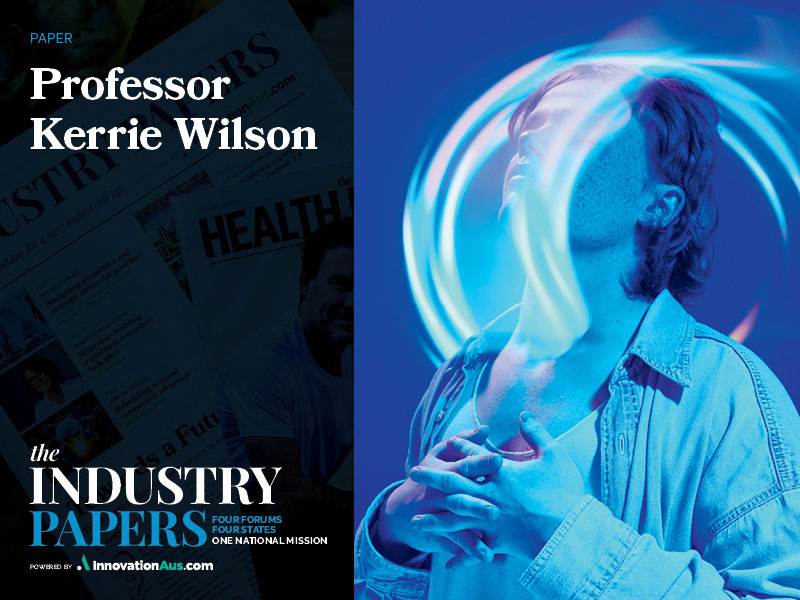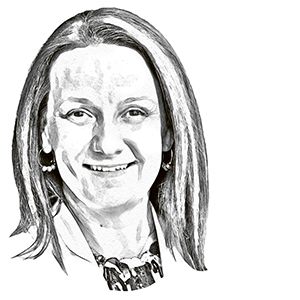The Guinness World Record for the longest-running laboratory experiment is a title still held by the University of Queensland for its Pitch Drop experiment. It began in 1927 with a glass funnel containing black pitch – a tar-like substance. The unique “live stream” experiment reveals solids can unexpectedly act like fluids, a discovery with profound implications.
Although pitch seems an outdated material today, the principles and lessons derived from the experiment are timeless.

One drop of pitch has fallen on average every ten years since the Pitch Drop experiment began, which reminds us that scientific progress demands time, patience and unwavering dedication.
Progress almost always requires a willingness to transcend disciplinary boundaries, in this case physics and chemistry.
Since Queensland’s Smart State Strategy commenced in 1998 and more recently the Advance Queensland Innovation for a Future Economy Roadmap, each investment has been like a drop of water, steadily filling a reservoir of innovation while growing new industries and driving transformation in critical sectors such as agriculture, health, mining, and energy.
Queensland is powering forward with the recently released Future Queensland Science Strategy, ensuring we are world-leading in translating science to deliver sustainable economic growth and social and environmental outcomes.
Achieving this will require the current and next generation of scientists to move between disciplines to forge a future that capitalises on our discoveries and their translation.
From policy to on-ground action
Queensland farmers collaborate with the Department of Agriculture and Fisheries (DAF) from dawn to dusk to enhance intelligent farming.
Agriculture is being transformed through the Queensland AgTech Roadmap and Queensland Low Emissions Agriculture Roadmap.
These will help position Queensland as a global leader in AgriTech, and a partner of choice in the sustainable production and processing of food, fibre, foliage and other bioproducts.
If you were to spend just one day on a Queensland “smart farm” like those at Gatton or Emerald, you would experience knowledge turned into impact.
Morning: Automated irrigation at dawn ensures optimal crop hydration. Farmers use farm energy audit tools and a land management information system to analyse soil data, balancing economic and environmental needs.
Mid-morning: Robotics control spraying operations, eliminating chemical waste, and collect soil data, allowing staff resources to be used for priority tasks.
Afternoon: Low-emission tractors transport produce. Researchers deploy drones to monitor crop conditions, supporting improved productivity.
Evening: Farmers access and evaluate the data for future planning, supported by DAF experts and extension staff, ensuring informed decision-making.
Night: Automated systems continuously monitor soil and crop health, providing real-time insights and adjustments.
The same innovative spirit driving Queensland’s smart farms extends to groundbreaking research efforts statewide.
For example, University of the Sunshine Coast molecular biologist Dr Shaodong Guo and his team carefully extract spider venom in a high-tech lab. With $240,000 from Advance Queensland’s Industry Research Fellowships, they prepare a bioinsecticide solution to target swarms of destructive locusts.
The liquid venom is a breakthrough, reducing chemical pesticide use and safeguarding crops and beneficial insects. Researchers deploy this bioinsecticide in test fields as the sun rises, watching intently as the eco-friendly solution takes effect.
This offers a glimpse into a more sustainable future for Queensland agriculture. An engineer for SwarmFarm Robotics, Alex Lawrie, captures the practical vision: “We are trying to improve the way we farm, not just automate the existing practices.”
Team Queensland and net zero
Patience is a virtue, but ambition and action are essential as the sun sets on fossil fuel technologies, including those used in tractors and turbine harvesters.
The Zero Net Emissions Agriculture Cooperative Research Centre, supported by $300 million in funding over ten years, aims to achieve zero net emissions from agriculture by 2040.
This will transform Queensland’s approach to sustainable farming through rapid research and technological innovation.
Meanwhile, the Queensland Energy and Jobs Plan targets 70 per cent renewable energy by 2032 and 80 per cent by 2035, driving a sustainable and prosperous future.
The Queensland Decarbonisation Hub brings knowledge, people and innovation together to help deliver our clean energy future.
A multidisciplinary network of researchers is working with First Nations, industry, and community leaders to develop strategies to rapidly reduce emissions, while supporting economic growth, creating new industries and local jobs, and protecting the environment.
The Decarb Hub demonstrates one of Queensland’s greatest scientific strengths – harnessing collaborations to solve the big challenges we face.
Our “Team Queensland” approach supports the collaborative use of university and shared infrastructure and cross-agency research partnerships to translate scientific knowledge and findings into practical industry, community and government applications.
Queensland is a world leader in finding opportunities to use science to make new discoveries, create new businesses and enhance the impact of science for everyone.
Read on for a look into our future state, building on the programs supported through the Queensland Government’s investment in Advance Queensland.
Biotechnology and health
In a state-of-the art lab, scientists carefully extract compounds from native plants, crafting a new medicine to combat a rare disease, and a team of researchers celebrates a breakthrough in cancer treatment using cell-based technology to target tumours.
Their work aligns with the $280 million Translational Science Hub involving Sanofi, the University of Queensland, and Griffith University, turning the state’s biodiversity into life-saving solutions. This research centre will help drive the development of new vaccines and health care solutions.
Defence, aviation and space
Researchers monitor an uncrewed aerial vehicle’s test flight.
Simulation experts train pilots in a high-tech control room for real-world scenarios, facilitated by the Queensland Defence Science Alliance, ensuring the state remains at the forefront of aviation and defence innovation.
Environment and nature
In Far North Queensland, a research team tests biofuel derived from local crops. Against the tranquil backdrop of Queensland’s wetlands in Central Queensland, scientists sample water and test for pollutants.
Their data shows innovative new land management practices and tools are improving farm productivity and the quality of water flowing to the Great Barrier Reef.
Renewable energy
New generation solar panels gleam in a field as researchers monitor their increased output thanks to quantum computing identifying more efficient materials. Nearby, biofuel experts refine algae-based energy solutions.
These contribute to the renewable energy targets set by the Queensland Energy and Jobs Plan, turning natural resources into sustainable lifelines. The $570 million Queensland Battery Industry Strategy means we are the driving force in new energy storage technologies, meeting the tenfold demand for battery storage by 2030.
From smart to quantum state
While all these initiatives contribute to Queensland’s ambition of becoming a global innovation hub, they are a drop in the ocean compared to our quest to lead in quantum technology.
The $89.7 million Queensland Quantum and Advanced Technologies Strategy and the Queensland Quantum Academy are excellent examples of how we are proactively building systems to advance emerging deep technologies that will transform our future.
The Queensland government has made the largest quantum commitment of any Australian state or territory.
Progress will profoundly shape and amplify all the sectors I have mentioned. Smartphones and MRI machines were made possible by the knowledge developed through studying quantum science.
And with Queensland’s legacy in quantum technology spanning more than 30 years, we intend to make our second mark in this industry: one which CSIRO estimates may be worth $2.2 billion by 2030, growing to $6 billion by 2045 and creating up to 19,400 jobs.
Unlike the Pitch Drop experiment’s slow, steady progress, opportunities arising from quantum technology demand lightning speed to turn potential into reality and make our state a magnet for talent and investment.
Queensland universities already host the headquarters of two of the four national quantum-related ARC Centres of Excellence, and they have a significant footprint in the other two.
The Queensland government’s partnership with the Australian government for frontier technology company PsiQuantum to build the world’s first fault-tolerant quantum computer in Brisbane is the most visible and significant investment.
It will create up to 400 new skilled job openings and establish partnerships with our local quantum industry and advanced manufacturing clusters.
Queensland’s experience in semiconductors, superconductors, and photonics will be essential for delivering market-ready quantum devices that may take centre stage at the Brisbane 2032 Olympic and Paralympic Games and create trailblazing new businesses and industries.
Quantum technologies will also help us revolutionise the fight against climate change.
Here are a few ways the future may unfold as we ‘quantise’ Queensland’s innovation ecosystem:
Quantum biotechnology breakthrough
The University of Queensland deploys quantum sensors to create a portable brain imager. Their real-time brain function insights promise to revolutionise early neurological diagnostics and treatment.
Silicon carbide power electronics innovation
Engineers at the Queensland Microtechnology Facility develop advanced Silicon Carbide components using quantum mechanics principles. Their innovation enhances energy conversion for electric vehicles and solar systems, driving sustainable energy solutions with significant size and cost reduction.
Quantum communication and security
Researchers at Griffith University achieve ultra-secure data transmission. Their breakthrough in quantum encryption ensures interception-proof communication, potentially transforming security in finance and national defence.
Quantum computing for chemical research
Scientists at the University of Queensland use quantum computers to simulate complex chemical reactions. Their groundbreaking simulations promise targeted, efficient solutions and pave the way for drug development and materials science advancements.
Our next leap
Excellence in science has been our ticket to success in Queensland. And we are starting to see the benefits of the government’s significant investment in leading-edge infrastructure and innovative places.
We must uphold our leadership by promoting Queensland’s scientific capability nationally and internationally to attract increased investment and more talent to the state.
Just as each drop of pitch reveals profound insights over time, every breakthrough in science will shape our future.
There are so many opportunities to use the power of science to unlock solutions that will address the emerging and long-term issues we face.
Queensland is well positioned to take advantage of the rise of the digital economy, the biotech revolution, the proliferation of artificial intelligence and robotics, and the circular economy.
Working together, we will transform the Queensland economy to one where innovation, science, research and entrepreneurship are the key drivers of new industries, growth and jobs.
Professor Kerrie Wilson, Queensland Chief Scientist. Professor Wilson is an affiliated professor in Conservation Science at The University of Copenhagen, and a member of the Australian Heritage Council. Previously, Professor Wilson was QUT Pro Vice-Chancellor (Sustainability and Research Integrity) and executive director of the QUT Institute for Future Environments. Before joining QUT in 2019, she was the director of the Australian Research Council (ARC) Centre of Excellence for Environmental Decisions and an ARC Future Fellow at the University of Queensland. She holds a Bachelor in Environmental Science (First Class Honours) from the University of Queensland and a PhD from The University of Melbourne.
This article is part of The Industry Papers publication by InnovationAus.com. Order your hard copy here. 36 Papers, 48 Authors, 65,000 words, 72 page tabloid newspaper + 32 page insert magazine.
InnovationAus.com would like to thank our sponsors Geoscape Australia, The University of Sydney Faculty of Science, the Semiconductor Sector Service Bureau (S3B), AirTrunk, InnoFocus, ANDHealth, QIMR Berghofer, Advance Queensland and the Queensland Government.
Do you know more? Contact James Riley via Email.

